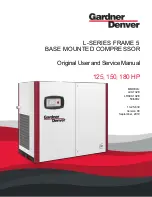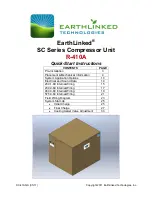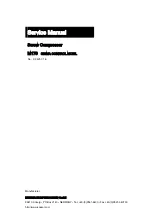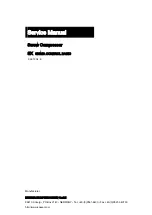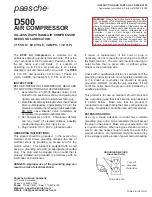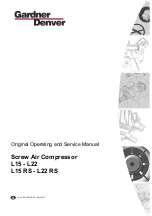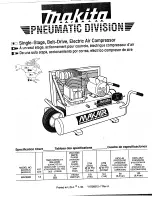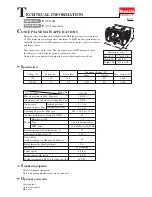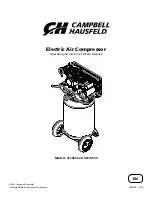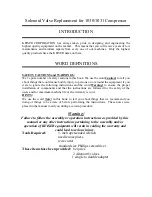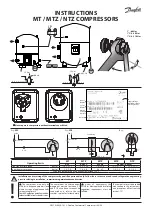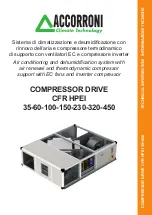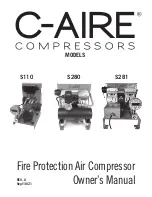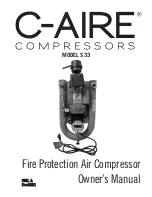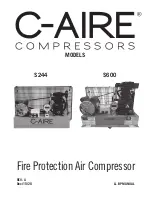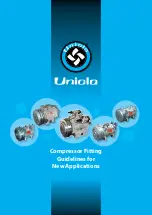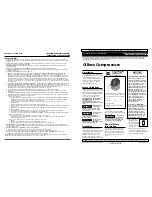
EX8000, WL5000 Serie de modelos para contratistas
19 Sp
Problema
Posible(s) Causa(s)
Acción a Tomar
La presión del tanque
disminuye cuando el
compresor se apaga
Exceso de humedad en
el aire de salida
Compresor funciona
constantemente
Compresor vibra
El suministro de aire es
menos de lo normal
1. Conecciones flojas (coneciones,
tuberías, etc.)
2. La llave de salida está floja
3. Hay fugas en la válvula de chequeo
1. Exceso de agua en el tanque
2. Humedad alta
1. Presostato está dañado
2. Excesivo uso de aire
Pernos están flojos
1. Válvulas de entrada están rotas
2. Filtro de entrada está sucio
3. Fugas en las conecciones
1. Chequée todas las conecciones con agua enjabonada
y apriete las conecciones flojas
2. Apriete la llave
3. Desmantele la válvula de chequeo, límpiela o
reemplácela
Antes de desmantelar la
válvula de chequeo
purgue el aire del tanque
1. Drene el tanque
2. Mueva el compresor a un área menos humeda; use
un filtro de línea
1. Reemplácelo
2. Disminuya el uso de aire; el compresor no tiene la
capacidad de suministro necesaria
Apriete los pernos
1. Un técnico autorizado de servicio debe repararlo
2. Limpie o reemplace el filtro de entrada
3. Apriete las conecciones
!
PELIGRO
Guía de Diagnóstico de Averías (Continuación)
Portable Air Compressors
2
General Safety
(Cont.)
codes, as well as the National Electrical
Code (NEC) and the Occupational
Safety and Health Act (OSHA).
8. Wiring and fuses should follow
electrical codes, current capacity, and
be properly grounded.
9. Electric motors must be securely and
adequately grounded. See grounding
instructions and extension cord
information, in this manual.
10. Always disconnect power source
before working on or near a motor, or
its connected load. If power
disconnect point is out-of-sight, lock it
in the open position and tag to
prevent unexpected application of
power.
11. Guard all moving parts; keep visitors
away. Never allow children in work
area.
12. Use only a properly grounded outlet
that will accept a three pronged plug,
and wear shoes to prevent shock
hazards.
13. Be careful when touching exterior of
operating motor; it may be hot
enough to cause injury.
14. Protect power cable from coming in
contact with sharp objects.
15. Clean electrical or electronic
equipment with an approved cleaning
agent, such as dry, nonflammable
cleaning solvent.
16. To avoid spontaneous combustion,
discard waste rags into approved
metal waste cans.
17. Never store flammable liquids or gases
in vicinity of compressor.
18. When spraying with solvent of toxic
chemicals, follow instructions provided
by the chemical manufacturer.
19. Spray in a well ventilated area, to
keep fumes from collecting and
causing health and fire hazards.
20. Do not spray in vicinity of open flames
or other places where a spark can
cause ignition. Do not smoke when
spraying paint, insecticides, or other
flammable substances.
21. Use a respirator when spraying.
22. NEVER reset safety valve or pressure
switch. Keep safety valve free from
paint and other accumulations. This
provides safety against over pressure.
23. Do regular maintenance; keep all
nuts, bolts, and screws tight, to be
sure equipment is in safe working
condition .
24. Keep cleaning rags and other
flammable waste materials in a tightly
closed metal container and dispose of
later in the proper fashion.
25. Drain tanks of moisture after each
day’s use. If unit will not be used for a
while, it is best to leave drain cock
open until such time as it is to be used.
This will allow moisture to completely
drain out and help prevent corrosion
of inside of tank.
26. Inspect tank yearly for rust, pin holes
or any other imperfections that could
cause it to become unsafe. NEVER
weld or drill holes in air tank.
Assembly
FEET (3 GALLON MODELS ONLY)
Insert threaded post of rubber foot into
hole in ground iron. Tighten securely
with locknut.
Installation
1. Check and tighten all bolts, fittings,
etc., before operating compressor.
2. Operate compressor in a ventilated
area so that compressor may be
properly cooled.
3. Compressor should be located where
it can be directly plugged into an
outlet, but if this is not possible, an
extension cord may be used. It should
be selected using the extension cord
chart on page 3 as a guide.
4. To avoid loss of power and
overheating, it is better to use
additional air hose instead of
extension cords to reach work area.
WIRING
1. Local electrical wiring codes differ from
area to area. Source wiring, plug and
protector must be rated for at least the
amperage and voltage indicated on
motor nameplate, and meet all
electrical codes for this minimum .
2. Use a slow blow fuse type T or a
circuit breaker.
Overheating, short
circuiting and fire
damage will result from inadequate
wiring, etc.
NOTE:
120 volt, 10 and 13 amp units can
be operated on a 115 volt, 15 amp circuit
under the following conditions:
a. No other electrical appliances or lights
are connected to the same branch
circuit.
b. Voltage supply is normal.
c. Extension cords are of the minimum
gauge specified in this instruction
manual.
d. Circuit is equipped with a 15 amp
circuit breaker or a 15 amp slow blow
fuse type T.
3. If above conditions cannot be met or
if nuisance tripping of current
protection device occurs, it may be
necessary to operate compressor from
a 115 volt, 20 amp circuit.
GROUNDING INSTRUCTIONS
1. This product should be grounded. In
the event of an electrical short
circuit, grounding reduces risk of
electrical shock by providing an
escape wire for electric current. This
product is equipped with a cord
having a grounding wire with an
!
CAUTION
Figure 1
www.chpower.com
Nut
Foot
Summary of Contents for WL5000 Series
Page 2: ...stas ada r la se a ...
Page 4: ...as ...







